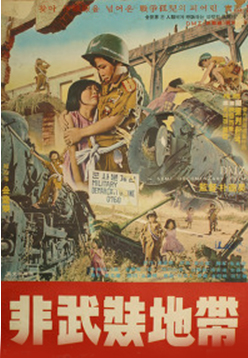DMZ (1965)
26th June 2010
 I recently purchased the lasted KOFA release, DMZ, and after watching it I am happy to say that I was happily surprised. I had read a little bit about the story prior to watching it and I was expecting a fairly standard 60s melodrama. And if I had watched the original 90-minute theatrical release, that is exactly what I would have seen. I did not count on was the editing skills of director Park Sang-ho. Recognizing that the drama part of his ’semi-documentary’ was lacking and the happy ending detracted from the power of the film, Park cut close to 30 minutes out of the movie–all scenes involving famous actors and actress were removed. All that remains are the children and one or two other characters who are briefly on screen. It was this version that won several ‘Best Documentary’ prizes between 1965 and 1967. (This is confused in the English part of the booklet that came with the DVD–I was very confused after reading it and it said that the theatrical version survived even though the film I watched clearly was just an hour long. However, after comparing that chapter with the Korean version also in the booklet, I realized it was mistranslated.)
I recently purchased the lasted KOFA release, DMZ, and after watching it I am happy to say that I was happily surprised. I had read a little bit about the story prior to watching it and I was expecting a fairly standard 60s melodrama. And if I had watched the original 90-minute theatrical release, that is exactly what I would have seen. I did not count on was the editing skills of director Park Sang-ho. Recognizing that the drama part of his ’semi-documentary’ was lacking and the happy ending detracted from the power of the film, Park cut close to 30 minutes out of the movie–all scenes involving famous actors and actress were removed. All that remains are the children and one or two other characters who are briefly on screen. It was this version that won several ‘Best Documentary’ prizes between 1965 and 1967. (This is confused in the English part of the booklet that came with the DVD–I was very confused after reading it and it said that the theatrical version survived even though the film I watched clearly was just an hour long. However, after comparing that chapter with the Korean version also in the booklet, I realized it was mistranslated.)
The acting of the children in the movie is quite good and the ending is very powerful. What is even more interesting is the story of the making of the film. Park decided to make a story about the DMZ after talking with some foreign tourists in Japan who wanted to visit it. It saddened him that this scar across the nation had become a tourist attraction (It still is today…). Citizens are not allowed in the demiltarized zone which stretches for two kilometers on each side of the 38th Parallel. However, Park received special permission to film within the southern section of that area and was accompanied by armed guards and mine detector units. Landmines were a real problem and Park Sang-ho admits to being terrified for the children who kept running around between shots. Landmines also play a significant role in the film on more than one occassion.
Naturally, because of the time it was made, Park got in trouble with censors and the government. In the sixties, to talk about reunification could have you labeled as a communist and subject to criminal investigation. Park was questioned about the scene where the children on the 38th Parallel–which is just marked by tape–barbed wire fences only exist at the 2km marks to the north and south. The children’s actions while ‘marking their territory’ (literally in the boy’s case who is playing the south) and then sitting with their backs to each other refusing to speak spoke volumes of Park’s opinion of the situation. Fortunately, the making of the film had received a lot of press and people wanted to see it, so with some editing for the theatrical version, it was allowed to screen. One of the things he had to cut from the film was the signs marking the DMZ, but these appear in the documentary version as does the above-mentioned scene with the children.
The original film had subtitles burned into it for the film festival, and these remain, however KOFA has added new, better subtitles to the DVD. I recommend this movie–but not as a movie. It was filmed on location and Park mentions that many of the things they shot around–the abandoned train, the destroyed tank, the ruined village–were all there. It is an intersting slice of history that I found surprising good even 45 years after the film was made.
